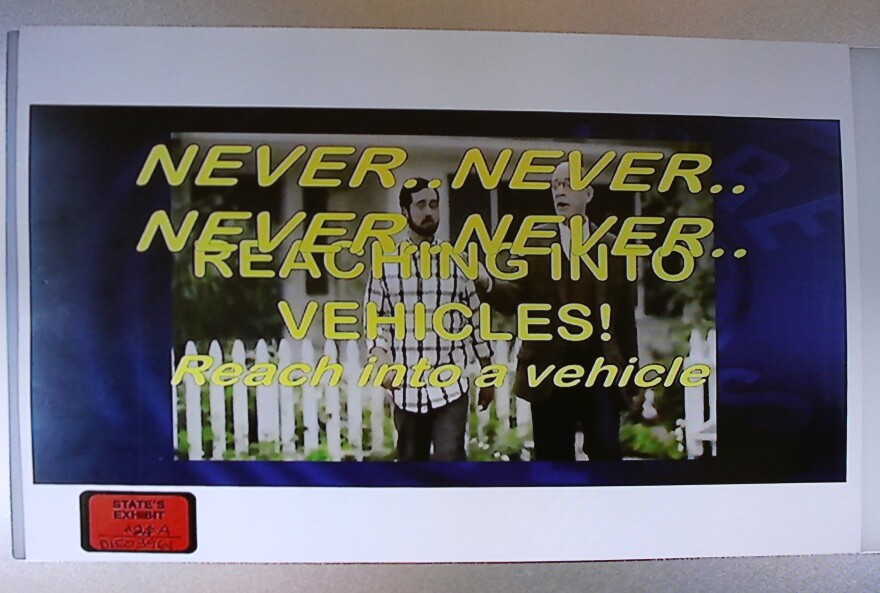Ray Tensing's attorney in his murder retrial attempted Tuesday to undercut the prosecution's forensic video expert. Stew Mathews characterized Grant Fredericks analysis of Tensing's body camera video as 20/20 hindsight.
"You don't consider yourself a Monday morning quarterback using 20/20 hindsight to tell these ladies and gentlemen of the jury what's depicted in that three second video?," Mathews asked.
"No," said Fredericks, "because this is real information as opposed to conjecture. 'What if,' 'I wish I had done something differently.' This is actually a forensic examination of fact."
Mathews also asked Fredericks to repeatedly state the car was in motion when the shot was fired. Fredericks noted it would only have moved a foot or two in less than a second before the fatal shot occurred.
Mathews challenged Fredericks to concede Tensing was falling when he fired, but Fredericks maintained that was not the case.
Fredericks also asserted the video doesn't support UC police officer Kidd's and Lindenschmidt's statements that they heard tires squealing before the shot was fired. Fredericks stated had there been squealing tires from DuBose's car, it would be heard on the video since the camera's microphone was pointed toward the car.
Finally, Fredericks testified it was his opinion the car's tires may have been turned, as was the steering wheel, allowing the car to move slightly left without assistance from the driver. He also noted DuBose would have been dead and therefore not in control of the car immediately after the shot. The defense objected to that last statement, though the prosecution said the coroner will prove that during her testimony.
Police use-of-force expert Scot Haug, a Post Falls, Idaho police chief, was called next to address Tensing's actions during the traffic stop.
Haug described Tensing as professional and courteous at the beginning of the stop but questions his actions moments before the shooting. He noted that Tensing could've seen that officers Kidd and Lindenschmidt were arriving on the scene.
"He simply could have de-escalated, disengaged, and had them try and stop Mr. DuBose instead of lunging inside of that (vehicle)," Haug offered.
Haug stated that after reviewing all the of the evidence, it was his opinion that the shooting was not justified and Tensing's use of force was unreasonable
"I think there was tactical error made in this case," Haug testified. "In reviewing the video, I can see at no time was Mr. Tensing tangled in the vehicle. He simply could have de-escalated the situation by stepping back and using some other method to apprehend Mr. DuBose."
"So, even though there was a tactical error," asked assistant prosecutor Seth Tieger, "it still wouldn't be justified in your opinion?"
"It wouldn't," Haug confirmed.
"Because there was no evidence that he was in fear of death or great bodily harm?," Tieger followed up.
"That's correct," Haug said again.
On cross examination, however, attorney Stew Mathews disagreed suggesting as he did with Grant Fredericks that was Tensing very close to DuBose's tires as the car moved past him.
The defense sought to further punch holes in testimony offered by prosecution witnesses Tuesday.

Hamilton Township Police Chief Scott Hughes taught Tensing during a December, 2014 class on the fundamentals of traffic stops. Hughes testified he teaches officers to never reach into a car during a traffic stop. The prosecution displayed an image Hughes uses in his seminar saying as much.
Hughes concedes that officers do sometimes reach into cars though.
The defense struck on an example from the chief's training which sites an incident involving Cincinnati police officer Kevin Crayon. Crayon, a 25-year police veteran, died after being dragged when he reached into a car in September, 2000.
Testimony will continue Wednesday with the prosecution expected to call several witnesses from the Hamilton County Coroner's office.
Judge Leslie Ghiz has hinted she may be intended to wrap up testimony by the end of the week, telling jurors to be prepared to go until 2 p.m. or 2:15 p.m. the rest of the week and even later, possibly, on Friday.
[Click here to view the archived Twitter feed if the content below isn't displayed.]



